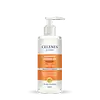What's inside
What's inside
 Key Ingredients
Key Ingredients

 Benefits
Benefits

 Concerns
Concerns

No concerns
 Ingredients Side-by-side
Ingredients Side-by-side

Water
Skin ConditioningSodium Lauroyl Methyl Isethionate
CleansingSodium Cocoamphoacetate
CleansingCoco-Glucoside
CleansingGlyceryl Oleate
EmollientSteareth-100/PEG-136/Hdi Copolymer
Propanediol
SolventPhenethyl Alcohol
MaskingUndecyl Alcohol
AntiseborrhoeicTocopherol
AntioxidantAnhydroxylitol
HumectantXylitol
HumectantHexylene Glycol
EmulsifyingCapryloyl Glycine
CleansingXylitylglucoside
HumectantMagnesium Aspartate
Skin ConditioningZinc Gluconate
Skin ConditioningCopper Gluconate
Skin ConditioningHippophae Rhamnoides Fruit Extract
Skin ConditioningCitrus Limon Peel Extract
EmollientChamomilla Recutita Flower Extract
MaskingCamellia Sinensis Leaf Extract
AntimicrobialCitric Acid
BufferingDisodium EDTA
Water, Sodium Lauroyl Methyl Isethionate, Sodium Cocoamphoacetate, Coco-Glucoside, Glyceryl Oleate, Steareth-100/PEG-136/Hdi Copolymer, Propanediol, Phenethyl Alcohol, Undecyl Alcohol, Tocopherol, Anhydroxylitol, Xylitol, Hexylene Glycol, Capryloyl Glycine, Xylitylglucoside, Magnesium Aspartate, Zinc Gluconate, Copper Gluconate, Hippophae Rhamnoides Fruit Extract, Citrus Limon Peel Extract, Chamomilla Recutita Flower Extract, Camellia Sinensis Leaf Extract, Citric Acid, Disodium EDTA
Water
Skin ConditioningMyristic Acid
CleansingGlycerin
HumectantMethylpropanediol
SolventPotassium Hydroxide
BufferingCoco-Glucoside
CleansingLauric Acid
CleansingPalmitic Acid
EmollientStearic Acid
CleansingGlyceryl Stearate
EmollientPotassium Cocoyl Glycinate
Parfum
MaskingSalicylic Acid
MaskingEthylhexylglycerin
Skin ConditioningButylene Glycol
HumectantDecylene Glycol
Skin ConditioningDisodium EDTA
Sorbitan Olivate
EmulsifyingHydrogenated Lecithin
Emulsifying1,2-Hexanediol
Skin ConditioningPropanediol
SolventCentella Asiatica Extract
CleansingFicus Carica Fruit Extract
HumectantAmaranthus Caudatus Seed Extract
Skin ConditioningUlmus Davidiana Root Extract
Skin ConditioningTorreya Nucifera Seed Oil
EmollientCeramide NP
Skin ConditioningAcmella Oleracea Extract
Skin ProtectingTocopherol
AntioxidantArgania Spinosa Kernel Oil
EmollientCandida Bombicola/Glucose/Methyl Rapeseedate Ferment
AntimicrobialCapryloyl Glycine
CleansingSesamum Indicum Seed Oil
EmollientHexylene Glycol
EmulsifyingPEG-60 Almond Glycerides
EmulsifyingCaprylyl Glycol
EmollientSarcosine
Skin ConditioningSerenoa Serrulata Fruit Extract
Skin ConditioningBeta-Sitosterol
Emulsion StabilisingCinnamomum Zeylanicum Bark Extract
AntimicrobialPotassium Sorbate
PreservativeCarbomer
Emulsion StabilisingOleanolic Acid
Skin ConditioningNordihydroguaiaretic Acid
AntioxidantWater, Myristic Acid, Glycerin, Methylpropanediol, Potassium Hydroxide, Coco-Glucoside, Lauric Acid, Palmitic Acid, Stearic Acid, Glyceryl Stearate, Potassium Cocoyl Glycinate, Parfum, Salicylic Acid, Ethylhexylglycerin, Butylene Glycol, Decylene Glycol, Disodium EDTA, Sorbitan Olivate, Hydrogenated Lecithin, 1,2-Hexanediol, Propanediol, Centella Asiatica Extract, Ficus Carica Fruit Extract, Amaranthus Caudatus Seed Extract, Ulmus Davidiana Root Extract, Torreya Nucifera Seed Oil, Ceramide NP, Acmella Oleracea Extract, Tocopherol, Argania Spinosa Kernel Oil, Candida Bombicola/Glucose/Methyl Rapeseedate Ferment, Capryloyl Glycine, Sesamum Indicum Seed Oil, Hexylene Glycol, PEG-60 Almond Glycerides, Caprylyl Glycol, Sarcosine, Serenoa Serrulata Fruit Extract, Beta-Sitosterol, Cinnamomum Zeylanicum Bark Extract, Potassium Sorbate, Carbomer, Oleanolic Acid, Nordihydroguaiaretic Acid
Ingredients Explained
These ingredients are found in both products.
Ingredients higher up in an ingredient list are typically present in a larger amount.
Capryloyl Glycine is created by adding an acyl group to glycine and caprylic acid chloride.
It is a cleanser due to its surfactant properties. Surfactants help dirt, oil, and other polluants be more easily rinsed away. According to manufacturers, Capryloyl Glycine also helps soften the skin and regulate sebum production.
Emerging studies show Capryloyl Glycine may inhibit hair growth. It may also cause allergies for some people. We recommend speaking with a professional if you have any questions about this ingredient.
Learn more about Capryloyl GlycineCoco-Glucoside is a surfactant, or a cleansing ingredient. It is made from glucose and coconut oil.
Surfactants help gather dirt, oil, and other pollutants from your skin to be rinsed away.
This ingredient is considered gentle and non-comedogenic. However, it may still be irritating for some.
Learn more about Coco-GlucosideDisodium EDTA plays a role in making products more stable by aiding other preservatives.
It is a chelating agent, meaning it neutralizes metal ions that may be found in a product.
Disodium EDTA is a salt of edetic acid and is found to be safe in cosmetic ingredients.
Learn more about Disodium EDTAHexylene Glycol is a surfactant. Glycols are a class of alcohols. Hexylene Glycol is a surfactant and emulsifier.
As a surfactant, Hexylene Glycol helps gather dirt and oil on your skin to be washed away.
As an emulsifier, Hexylene Glycol helps keep water and oil together. This prevents them from separating in a product. Hexylene Glycol also thins out the texture of a product by lessening viscosity.
Hexylene Glycol has a small molecular weight.
Learn more about Hexylene GlycolPropanediol is an all-star ingredient. It softens, hydrates, and smooths the skin.
It’s often used to:
Propanediol is not likely to cause sensitivity and considered safe to use. It is derived from corn or petroleum with a clear color and no scent.
Learn more about PropanediolTocopherol (also known as Vitamin E) is a common antioxidant used to help protect the skin from free-radicals and strengthen the skin barrier. It's also fat soluble - this means our skin is great at absorbing it.
Vitamin E also helps keep your natural skin lipids healthy. Your lipid skin barrier naturally consists of lipids, ceramides, and fatty acids. Vitamin E offers extra protection for your skin’s lipid barrier, keeping your skin healthy and nourished.
Another benefit is a bit of UV protection. Vitamin E helps reduce the damage caused by UVB rays. (It should not replace your sunscreen). Combining it with Vitamin C can decrease sunburned cells and hyperpigmentation after UV exposure.
You might have noticed Vitamin E + C often paired together. This is because it is great at stabilizing Vitamin C. Using the two together helps increase the effectiveness of both ingredients.
There are often claims that Vitamin E can reduce/prevent scarring, but these claims haven't been confirmed by scientific research.
Learn more about TocopherolWater. It's the most common cosmetic ingredient of all. You'll usually see it at the top of ingredient lists, meaning that it makes up the largest part of the product.
So why is it so popular? Water most often acts as a solvent - this means that it helps dissolve other ingredients into the formulation.
You'll also recognize water as that liquid we all need to stay alive. If you see this, drink a glass of water. Stay hydrated!
Learn more about Water